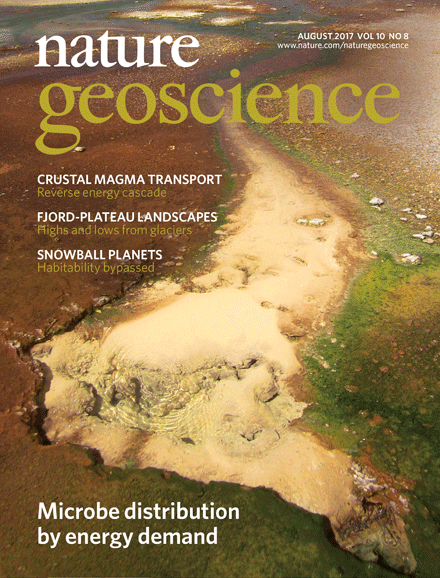-
Why Does a Yellowstone Microorganism Prefer Meager Rations Over Rich Ones?
November 07, 2017 / Posted by: Miki Huynh
Cover of Nature Geosciences featuring the research of M. Amenabar et al. The image shows overlapping gradients in mineral substrates capable of supporting microbial metabolism in a hot spring outflow channel in Yellowstone National Park, WY. Source: Nature Geosciences (August 2017 Volume 10 No 8)Scientists from the University of Wisconsin-Madison (UW), Arizona State University (ASU), and Montana State University (MSU) have teamed up to discover a puzzle at the junction of geochemistry and biology: Why would a microorganism thriving in a hot spring draw its energy from low-quality sources instead of rich ones?
The paper “Microbial substrate preference dictated by energy demand rather than supply” is published in Nature Geoscience, and authored by Maximiliano Amenabar (MSU, also with the NASA Astrobiology Institute (NAI) team at University of Colorado, Boulder (CUB)), Everett L. Shock (ASU and NAI teams at MIT and CUB), Eric Roden (UW and NAI team at UW), John Peters (MSU), and Eric Boyd (MSU and NAI teams at CUB, UW, and the Virtual Planetary Institute).
The excerpted press release by Robert Burnham is available through the Arizona State University website.
****
Arizona State University geoscientist Everett Shock has collaborated with a team of life scientists from Montana State University to discover a puzzle at the junction of geochemistry and biology.
The puzzle, which has no solution yet, is: Why would a microorganism thriving in a hot spring draw its energy from low-quality sources instead of rich ones?
Shock, who is a professor in geochemistry in ASU’s School of Earth and Space Exploration and the School of Molecular Sciences, has long studied questions of habitability as they apply to life on Earth, and to the potential for life on other planets.
“The team isolated this organism, which is a member of the Acidianus genus, from a hot spring in Yellowstone National Park and cultured it in the laboratory,” he said. “There it was given a choice of three different geochemical energy supplies.”
This microbe, Shock said, can get energy from combining hydrogen with sulfur, or hydrogen with iron, or sulfur with iron. In the experiments the team carried out, hydrogen and sulfur supplied the least energy, while hydrogen and iron provided the most.
“Surprisingly, the organism grew best on the lowest energy supply — and it grew the worst with the richest energy material,” Shock said.
“The results were quite counterintuitive,” said Shock. “It’s only natural to expect that in any environment, the ‘big deal’ energy sources will be supporting the most organisms, and the feeble sources — well, you wonder if they are supporting anything at all.”
It turns out, he explained, that in a genetic sense, it may be costly for the organism to go after the big-energy supply.
“It’s like mining,” he said. “You can have a rich ore deposit, but if extracting it costs more than you can get for it, it’s not worth pursuing.”
And in microorganism terms, Shock said, “biological cost may come down to availability. Perhaps the low-energy source is more reliable in nature than the high-energy one.”
Shock suggested that reliability could “tune” the microorganism’s metabolism to the energy source that’s always available.
But apparently not exclusively, he added. “The organism is also capable of using these other energy sources. However, maybe using them takes more work, so the organism grows more slowly with them.”
The focus of future research on this organism will be to assess in detail the energetic costs. Its recently completed genome will aid the research..
Shock concluded, “We don’t know for sure why this organism thrives best on low-energy food sources — but now the task becomes finding that out.”
Source: [Nature Geosciences]
- The NASA Astrobiology Institute Concludes Its 20-year Tenure
- Global Geomorphologic Map of Titan
- Molecular Cousins Discovered on Titan
- Interdisciplinary Consortia for Astrobiology Research (ICAR)
- The NASA Astrobiology Science Forum Talks Now on YouTube
- The NASA Astrobiology Science Forum: The Origin, Evolution, Distribution and Future of Astrobiology
- Alternative Earths
- Drilling for Rock-Powered Life
- Imagining a Living Universe
- Workshops Without Walls: Astrovirology